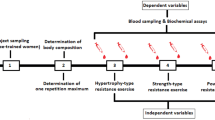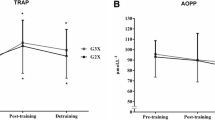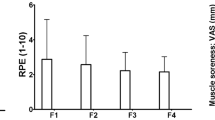Abstract
The purpose of this study was to compare power outputs, and blood concentrations of lipid hydroperoxides (LH), malondialdehyde (MDA), creatine kinase (CK), myoglobin (Mb) and lactate ([La−]B) following 30 s of maximal cycle ergometry when resistive forces were derived from total-body mass (TBM) or fat-free mass (FFM). Alpha-tocopherol (AT), retinol (R) and uric acid (UA) concentrations were also measured to qualify the activity of antioxidants. Cardiac troponin levels were determined to exclude myocardial damage and to verify that any CK was predominantly derived from skeletal muscle. Differences (P<0.05) in peak power output, pedal velocity and resistive forces were observed when the TBM and FFM protocols were compared [953 (114) W vs 1,020 (134) W; 134 (8) rpm vs 141 (7) rpm; 6 (1) kg vs 5 (1) kg respectively). LH and MDA concentrations increased immediately post-exercise during the TBM protocol only (P<0.05) and were greater when compared to FFM (P<0.05). LH and MDA values decreased 24 h post-exercise. Increases in CK concentrations were recorded immediately post-exercise for both the TBM and FFM protocols with greater concentrations recorded for TBM (P<0.05). Decreases were observed 24 h post-exercise. Mb concentrations were greater immediately post-exercise for the TBM protocol and were greater than those recorded for FFM (P<0.05). Values decreased 24 h later (P<0.05). AT and UA concentrations decreased immediately post-exercise for both protocols (P<0.05) and increased 24 h later (P<0.05). There were no changes observed in R concentrations at any of the blood sampling stages. [La−]B increased (P<0.05) immediately post-exercise for both protocols, and decreased 24 h later (P<0.05). The results of the study suggest that greater power outputs are obtainable with significantly less oxidative stress and muscle disruption when resistive forces reflect FFM mass as opposed to TBM.
Similar content being viewed by others
References
Alessio HM, Hagerman AE, Fulkerson BK, Ambrose J, Rice RE, Wiley RL (2000) Generation of reactive oxygen species after exhaustive aerobic and isometric exercise. Med Sci Sport Exerc 32 (9):1576–1581
Baker JS, Bailey D, Davies B (2001) The relationship between total-body mass, fat-free mass and cycle ergometer power components during 20 seconds of maximal exercise. J Sci Med Sport 4 (1):1–9
Balnave CD, Thompson MW (1993) Effect of training on eccentric exercise induced muscle damage. J Appl Physiol 75:1545–1551
Behnke AR, Wilmore JH (1974) Evaluation of body build and composition. Prentice Hall, Englewood Cliffs, N.J., pp 20–24
Cerny FJ, Haralambie G (1983) Exercise-induced loss of muscle enzymes. In: Knuttgen HG, Vogel JA, Poortmans J (eds) Biochemistry of exercise. Human Kinetics, Champaign, Ill., pp 441–446
Cheetham ME, Boobis LH, Brooks S, Williams C (1986) Human muscle metabolism during sprint running. J Appl Physiol 61:54–60
Clarkson MM, Nosaka K, Braun B (1993) Muscle function after exercise-induced muscle damage and rapid adaptation. Med Sci Sport Exerc 24:512–520
Cleary MA, Kimura IF, Sitler MR, Kendrick ZV (2002) Temporal pattern of the repeated bout effect of eccentric exercise on delayed-onset muscle soreness. J Athl Train 31:32–36
Coleman S (1996) Corrected Wingate Anaerobic Test. Cranlea, Birmingham, UK, pp 4–5
Dill DB, Costill DL (1974) Calculation of the percentage changes in volumes of blood, plasma and red cells in dehydration. J Appl Physiol 37:247–248
Gleeson N, Eston R, Marginson V, McHugh M (2003) Effects of prior concentric training on eccentric exercise muscle damage. Br J Sports Med 37:119–125
Groussard C, Rannou-Bekono F, Machefer G, Chevanne M, Vincent Sergent O, Cillard J, Gratas-Delamarche A (2003) Changes in blood lipid peroxidation markers and antioxidants after a single sprint anaerobic exercise. Eur J Appl Physiol 8:14–20
Heiser K (1989) Load optimisation for peak and mean power output on the Wingate Anaerobic Test. Masters thesis, Arizona State University
Hellsten-Westing Y, Ahlborg G, Jensen-Urstad M, Sjodin B (1988) Indication of in vivo xanthine oxidase activity in human skeletal muscle during exercise in man. Acta Physiol Scand 137:159–160
Hellsten-Westing Y, Ekblom B, Sjodin B (1989) The metabolic relation between hypoxanthine and uric acid in man following maximal short distance running. Acta Physiol Scand 137:341–345
Jaskolska A, Goossens P, B. Veenstra B, Jakolski A, Skinner JS (1999) Comparison of treadmill and cycle ergometer measurements of force–velocity relationships and power outputs. Int J Sports Med 20:92–197
Kanter MM (1994) Free radicals exercise and antioxidant supplementation. Int J Sports Nutr 4:205–220
Kyrolainen H, Timo T, Komi PV (1998) Muscle damage induced by stretch shortening cycle. Med Sci Sport Exerc 30 (3):415–420
Lindena J, Kupper W, Trautchold I (1984) Enzyme activities in thoracic duct lymph and plasma of anaesthetised, conscious, resting and exercised dogs. Eur J Appl Physiol 52:188–195
Li JX, Tong CWC, Xu DQ, Chan KM (1999) Changes in membrane fluidity and lipid peroxidation of skeletal muscle mitochondria after exhaustive exercise in rats. Eur J Appl Physiol 80:113–117
Lovlin R, Cottle W, Pyke I, Kavanagh M, Belcastro AN (1987) Are indices of free radical damage related to exercise intensity. Eur J Appl Physiol 56:313–316
Mair J, Mayr M, Muller E, Haid C, Artner-Dworzac E, Laurie C, Puschendorf B (1995) Rapid adaptation to eccentric induced muscle damage. Int J Sports Med 6:352–356
Marzatico F, Pansarasa O, Bertorelli L, Somenzini L, Della-Valle G (1997) Blood free radical antioxidant enzymes and lipid peroxides following long distance and lactacidemic performances in highly trained aerobic and sprint athletes. J Sports Med Phys Fit 37:235–239
Norman B, Sollevi A, Kaijer L, Jansson E (1987) ATP breakdown products in human skeletal muscle during prolonged exercise to exhaustion. Clin Physiol 7:503–509
Nourooz-Zadeh J, Tajaddini-Sarmadi J, Wolff SP (1994) Measurement of plasma hydroperoxide concentrations by ferrous oxidation-xylenol orange assay in conjunction with triphenylphosphine. Ann Biochem 22:403–409
Patton J, Murphy M, Frederick F (1985) Maximal power outputs during the Wingate anaerobic test. Int J Sports Med 6:82–85
Reilly T, Brooks GA (1982) Investigation of circadian rhythms in metabolic responses to exercise. Ergonomics 25:1093–1197
Saxon JM, Donelly AE (1995) Light concentric exercise during recovery from exercise enduced muscle damage. Int J Sports Med 16:347–351
Serresse O, Lortie C, Bouchard C, Boulay MR (1988) Estimation of the contribution of the various energy systems during maximal work of short duration. Int J Sports Med 9:456–460
Siri WE (1956) Gross composition of the body. In: Lawrence, JH, Tobias CA (eds) Advances in biological and medical physics, IV. Academic, New York, pp 239–280
Sjodin B, Westing YH, Apple FS (1990) Biochemical mechanisms for oxygen free radical formation during exercise. Sports Med 10 (4):236–254
Smith JC, Hill DW (1991) Contribution of energy systems during a Wingate power test. Brit J Sports Med 25 (4):196–199
Thurnham DI, Smith E, Flora PS (1988) Concurrent liquid chromatographic assay of retinol, alpha tocopherol, beta carotene, lycopene and beta cryptoxanthin in plasma, with tocopherol acetate as internal standard. Clin Chem 34 (2):377–381
Wilkie DR (1960) Man as a source of mechanical power. Ergonomics 3:1–8
Wilmore JH, Vodak PA, Parr RB, Girandola RN, Billing JE (1980) Further simplification of a method for determination of residual lung volume. Med Sci Sports Exerc 12:216–218
Young IS, Trimble ER (1991) Measurement of malondialdehyde in plasma by high performance liquid chromatography with fluorometric detection. Ann Clin Biochem 28:504–508
Author information
Authors and Affiliations
Corresponding author
Rights and permissions
About this article
Cite this article
Baker, J.S., Bailey, D.M., Hullin, D. et al. Metabolic implications of resistive force selection for oxidative stress and markers of muscle damage during 30 s of high-intensity exercise. Eur J Appl Physiol 92, 321–327 (2004). https://doi.org/10.1007/s00421-004-1090-9
Accepted:
Published:
Issue Date:
DOI: https://doi.org/10.1007/s00421-004-1090-9




